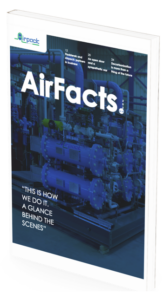Gobar Gas
Looking to explore the world of biogas processing and handling solutions? Get instant access to our documents about biogas technology.
With the United Nations and other international bodies making a priority of battling destructive climate change, countries all over the world are discovering new alternatives to fossil fuels. Sometimes, new recourse is found in things that have been available to humanity from the dawn of time, like wind and sun rays. Decaying organic matter is much the same: decomposing leaves and grasses; aging animal remains and waste; rotting food and byproducts; as well as sewage and wastewater are all sources of usable energy that power electrical grids and fuels automobiles and trucks. The energy is biogas or, in India, gobar gas.
Where Does It Come From?
When the materials mentioned above are bereaved of oxygen, bacteria begins to break them down into myriad chemical compounds. As this process — known as anaerobic digestion — runs its course, it yields end products, principally methane and carbon dioxide. It is the methane (CH4) that is the fruitful compound in that it can be burned in combustion engines to either actuate the generation of electricity or propel vehicles of varying sizes and designs. Anaerobic digestion has been a natural phenomenon forever but technology can hasten this sequence of events to create more biogas, ridding it of its impurities.
Biogas is noticeable when passing longstanding leaf piles or grass clipping masses. The odor emanating from these heaps originates at the bottom where no oxygen can penetrate. Little do people know the great potential that lies in such stench. Fortunately, scientific knowledge is at a place where the conditions at the base of that leaf pile can be replicated quickly and repeatedly. The inputs or substrate — often livestock manure, wastewater or other sorts of compost — are fed into an oxygen-free tank whereby the substrate is disintegrated and the biogas rises to the top and is captured for processing.
The apprehended biogas often contains chemical compounds that threaten human health, the durability of pipelines and the overall performance efficiency of the biogas. Thus, various means of cleansing the gas are employed during the processing phase. These range from utilizing liquid solutions that draw out contaminants to the refrigeration of the gas, causing the impurities to condense and separate. The residual solids — or digestate — is useful as crop fertilizer, feed additive, bedding and organic pesticide agents. All in all, the production of biogas is an efficient activity with few economic or ecological downsides.
Is It Widely Available in India?
The use of gobar gas has enormous implications for a nation-state like India. Millions of homes in India burn wood — about five kilograms daily on average — for heating and cooking. Although wood is sometimes classified as carbon-neutral, the volume at which it is consumed outpaces natural restoration. This massive activity hastens both deforestation and greenhouse gas emission. The good news is that private endowments and non-governmental organizations are working to equip households with biogas plants. An estimated 4,000 dwellings in India now have access to such small-scale production units.
This work on a micro level continues to expand. More broadly, India is the third largest importer of petroleum in the world. Others are working to lower this statistic by exploiting the huge amount of agricultural waste generated in India every day. Hence the emergence of commercial-scale biogas and gobar gas plants that convert the effluvium to electricity for use in commerce and industry. In the state of Maharashtra, for example, a new biogas facility is in the works where livestock manure and municipal waste will be digested and the methane combusted will power a solid oxide fuel cell that generates electricity.
The future of biogas in India will largely depend on the investment in infrastructure. The multiplication of each gobar gas plant will achieve this aim, coupled with facilities and conduits to better collect and pre-treat the agricultural, municipal and industrial waste necessary to reach a national goal of 36 percent of total energy production. To this end, the government hopes to construct 5,000 new gobar gas plants by 2023. Other sustainability initiatives involve the blending of biogas with natural gas extracted from the earth’s crust. This will both boost biofuel opportunities and reduce the dependency on energy imports.
An additional benefit is in the management of agricultural waste. According to the U.N. Food and Agriculture Organization (FAO), India is the planet’s largest milk producer. That equates to millions of heads of cattle, each prolific in manure creation. Waste management has long been a vexation for farmers the world over. With wise and sufficient investment, however, not only can Indian dairy farmers offload surplus manure, they can do so at a profit. Furthermore, the ash digestate from methane extraction is often a more nutritios fertilizer than the raw manure itself. Anaerobic digestion holds great promise for the Indian economy.
In Summary
The advances made in the production and processing of biogas positively impacts economies with significant rural sectors. Countries like India envision liberation from foreign energy dependence by tapping the enormous amounts of agricultural and municipal waste as media for anaerobic digestion. As it invests in energy conversion and substrate collection infrastructure, India looks forward to an economic uplift as well as an environmental stride toward mitigating the effects of climate change.




